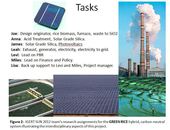Highlight
GREEN RICE: Generating Revenue from Electrical Energy Naturally to Reduce the Impact of Carbon Emissions
Achievement/Results
The 2012 IGERT: Solar Utilization Network (SUN) cohort, in response to challenges faced in the area of solar technology scale-up, developed the following proposal as a comprehensive, interdisciplinary approach involving various solar energy conversion approaches. The concept was the result of pondering the question: Can we design a carbon-neutral system that optimizes resources and produces electricity and other commodities?
The cohort selected utilization of rice husks, with the knowledge that rice husks are an underutilized byproduct of rice production, which is a renewable source of biomass, and that rice husk ash is about 95% silica, which has several commercial applications. The proposal envisions a hybrid system that combines the combustion of rice husks with a PBR that will create a valuable product (fuel, fertilizer, metabolite, nutraceutical) while taking up and cleaning flue gas. In addition this system will provide high-quality, solar-grade silica and electricity to the grid. This hybrid facility also will use and/or metabolize waste products (rice husks, waste water, etc.) (Figure 1). The prototype plant design would be on a one Megawatt scale as would be appropriate for a rice farm in California.
Once this technology is proven effective, the concept would be scaled up further with an eye on international deployment, perhaps in developing countries such as the Philippines, India and Cambodia. The team began by organizing and conducting research into the various aspects of this comprehensive, interdisciplinary strategy. Figure 2 illustrates the various tasks and assignments undertaken by each team member including system design, silica extraction, silica applications, generation of electricity, photobioreactor design, finance and policy, and project management. Over the course of the semester the concepts were honed and fine tuned into a PowerPoint presentation. As of this writing the students are completing a poster and video for submission to the annual 2013 IGERT Online Video and Poster Competition. This conceptual project was developed by the Arizona State University IGERT SUN 2012 student cohort – Levi Straka, Lisa Dirks, Joe Laureanti, Anna Beiler, Miles Brunda’ge, James LeBeau, Leah Haling – with assistance from IGERT SUN faculty Stephen Goodnick, Patrick Phelan, Thomas Moore, Cesar Torres, Harvey Bryan, David Guston, Willem Vermaas, and Jenefer Husman. Funding was provided by the National Science Foundation IGERT Grant #1144616.
Address Goals
The primary NSF strategic goal for the IGERT SUN program is to educate the next generation of leaders in guiding society toward a solar-based, sustainable energy future by training doctoral students who can see beyond the boundaries of traditional methodologies and disciplinary viewpoints, and who can integrate scientific excellence with societal and policy insights. This project illustrates how, from the onset, the IGERT SUN curriculum has been effective in fostering learning and collaborative thinking, and in encouraging interdisciplinary approaches to the complex issues involved in moving from a fossil-fuel-based society to a sustainable solar energy world.
The 2012 IGERT SUN cohort has shown teamwork in their organized approach and a willingness to tackle complex issues in an innovative way. A secondary NSF strategic goal for the program is to foster innovative research in the field of solar energy by providing the renewable energy community with innovators with the ability to make connections between problems from multiple solar energy sectors and find novel solutions to those problems. This project is an example of how the students are being trained to translate coursework into integrative project proposals across solar energy sectors. The project is novel in its approach and enhances collaborative discovery by students outside of their individual comfort zone.







